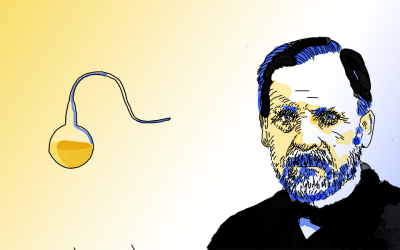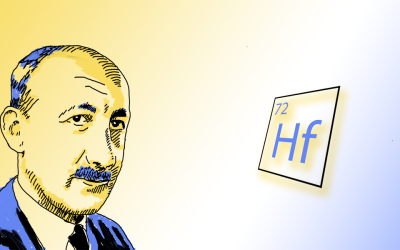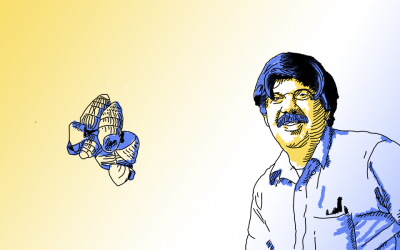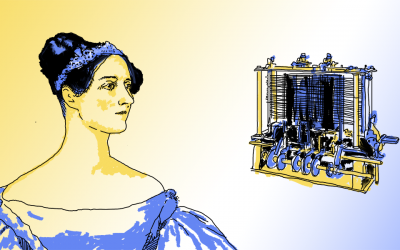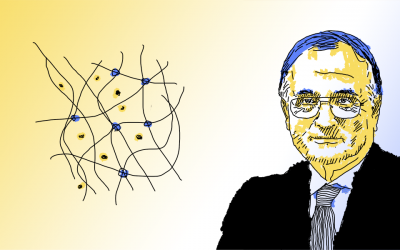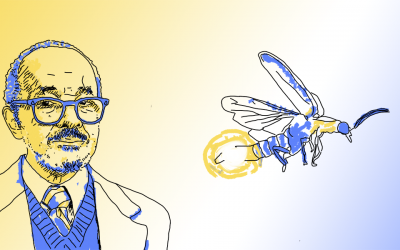Chien-Shiung Wu was a Chinese–American physicist who made significant contributions to nuclear and particle physics. Wu’s unequivocal expertise in beta decay during the fission, or splitting, of atoms made her a leading figure in physics during the mid-twentieth century, alongside well-known names such as Fermi, Einstein, and Curie.
She not only provided important insights during the Manhattan Project, but later provided pivotal evidence for the asymmetry of the Universe. “The work that made her famous changed scientists’ understanding of the Universe,” wrote Jada Yuan, her granddaughter, in an essay for The Washington Post. “It inspired countless girls and women.”
An unconventional upbringing
Born on May 29, 1912 in Liuhe, a small town near Shanghai, Wu was the middle daughter of three children. Her mother, Funhua Fan, was a teacher, and her father, Zhong-Yi Wu, an engineer. They were politically progressive and believed in equal rights for women and the education of girls. As a child, she attended a school that her parents had founded called Mingde Women’s Vocational Continuing School, the first elementary school in the region to admit and educate young girls.
Her father’s school could only take her so far, and it was he who encouraged her to continue with education for as long as she could. This was not a conventional path for a woman in China at the time, where they were instead traditionally relegated to roles within the home and family.
With her father’s support, she set off for a selective boarding school in Suzhou, some 80 km from home, at the age of 10. It was not an easy time, but her father had said to her: “Ignore the obstacles. Just put your head down and keep walking forward”, a sentiment she would carry throughout her life.
World-changing discoveries had been made during the 1920s, driven by Einstein’s theory of relativity — physics was an exciting field to be a part of and Wu’s passion was ignited. In 1930, she completed high school and was accepted to the National Central University in Nanjing, one of China’s most prestigious institutions. She began her education in math, but apparently was so inspired by Marie Curie and the study of physics that she changed her major, graduating with a degree in physics in 1934.
After this, she taught for a year at the National Chekiang University in Hangzhou and later began research in X-ray crystallography in the lab of Jing-Wei Gu, a female professor at the Academia Sinica. At the time, China did not have any graduate-level physics programs and so Gu encouraged her to pursue a degree in the United States.
A love of physics
In 1936, she left for the United States. Wu’s initial plans were to return to China after obtaining her degree, but with the Japanese invasion of China in 1937 and the chaos of World War Two, civil war, and revolution, she couldn’t know that it would be decades before she would ever return. “Waving from that boat was the last time she saw her parents alive,” wrote her granddaughter Jada Yuan.
Her sights were initially set on the University of Michigan. However, after a spontaneous visit to the University of California at Berkeley following her month-long Pacific crossing and arrival on the West Coast, she met her future supervisor, Ernest Lawrence, a nuclear physicist who would go on to win the 1939 Nobel Prize in Physics, as well as a fellow Chinese graduate student named Luke Chia-Liu Yuan. The two convinced her to stay, and she abandoned her initial plans, remaining in California instead.
Under Lawrence’s supervision, Wu explored the physics of radioactive decay, and following the discovery of uranium fission in 1938 by Otto Hahn and Fritz Strassmann, she began to study the products of this process. Her work centered on beta decay — a radioactive process in which an electron or positron (a beta ray) and a neutrino are emitted from an atomic nucleus.
She worked closely on the topic with the famous Italian physicist Emilio Segrè, with her thesis focusing on “Bremsstrahlung” (German for “breaking radiation”), which is the radiation produced by the sudden slowing or deflection of charged particles, such as electrons, by another particle, typically an atomic nucleus — xenon in Wu’s case. The second part of her thesis discussed the production of radioactive isotopes of xenon produced by the nuclear fission of uranium.
Adapting to life in America was challenging, and Wu is said to have missed her homeland, especially her family. With the outbreak of World War Two, communication with her family had been effectively cut off and for many years she heard nothing from them. Taking her father’s earlier advice, she threw herself into her work.
“Unmoored, and, I believe, desperate, she threw herself into her lab work, typically staying until 4 a.m,” wrote her granddaughter, Jada. “Every exam she took was propelled by the fear that if she failed, she’d have nowhere to go. Every time she passed, which was always, she celebrated at a Chinese restaurant.”
Wu was an exceptionally hard worker, working long hours and approaching every experiment with exacting detail. One of the members of her doctoral committee, J. Robert Oppenheimer, was so impressed by her work and understanding of the topic that he dubbed her “the authority” on beta decay. In 1940, she completed her Ph.D. and stayed on at Berkley for another two years, building credibility as a leading expert in the budding field of nuclear physics.
The Manhattan Project
Wu was not asked to stay on at Berkley on a permanent basis — a significant blow to her — and she had difficulty in securing any sort of faculty position at a leading university. This was an unfortunate reality of the discrimination faced by women at the time, where many prestigious universities still barred them from holding the more prestigious academic positions.
In 1942, Wu married Yuan and amid rising anti-Asian sentiment on the West Coast as a result of Japan’s attack on Pearl Harbor, the two moved to Massachusetts where Yuan had been offered a job at RCA Laboratories in Princeton, New Jersey. Wu got a job teaching physics at Smith College, a women’s college in Northampton, Massachusetts.
Living over 300 km apart meant the newlywed couple could only see each other on weekends. Wu was not happy with her current position — she missed research and being in the lab, venting her frustrations to Lawrence. With Lawrence’s recommendation, she received offers from several institutions, eventually selecting Princeton University in 1943 to be closer to Yuan, becoming the school’s first female physics instructor.
In 1944, Wu joined the Manhattan Project — the classified wartime initiative that was focused on building the first atomic bomb — as part of the Substitute Alloy Materials (SAM) Laboratories at Columbia University.
Wu’s initial contribution focused on developing better radiation detectors to help support the project’s program for uranium enrichment, which included improving Geiger counters. She was later asked to weigh in on a problem with the newly built B reactor, the first large-scale nuclear reactor based on experimental designs by Enrico Fermi at the University of Chicago, and a key component of the Manhattan Project. The purpose of the reactor was to convert natural uranium into plutonium-239 for weapons-grade use.
The problem was the self-sustaining chain reaction being carried out in the reactor would always reach a point where after a few hours it would peter out. Segrè is said to have remembered Wu’s Ph.D. thesis on the radioactive isotopes of xenon and advised Fermi to get in touch with her.
Wu was able to confirm that xenon, a product of the nuclear reaction, was indeed the culprit. It was causing the reaction to stall because it had such a high propensity for capturing the neutrons needed to keep it going and self-sustaining. She had a manuscript from her Ph.D. work detailing these findings, which had not yet been published due to the international arms race taking place around nuclear fission during World War Two.
She also later contributed to the enrichment of uranium ore by developing a process through which uranium could be separated into its isotopes, a crucial means for producing large enough quantities for the first atomic bomb.
Like many physicists involved in the Manhatten Project, Wu distanced herself from it following the detonation of the two bombs over Hiroshima and Nagasaki, killing between 129,000 and 226,000 people, most of whom were civilians. Wu rarely talked publicly about her feelings or involvement in the project, but in a meeting with the then president of Taiwan, Chiang Kai-shek, in 1962, she advised him not to embark on a nuclear program.
A Nobel snub
Following the war, Wu accepted a position as associate researcher at Columbia University where she would remain for the rest of her career, becoming the university’s first female tenured physics professor in 1952. She was the world’s leading expert in beta decay, and was approached by Tsung Dao Lee and Chen Ning Yang, two theoretical physicists who were working on a theory that during beta decay, the law of parity — that two physical systems, one of which is the mirror image of the other, behave in the same way — did not apply.
They needed help in proving their theory, and came to Wu to devise a series of experiments to do this. She traveled between her lab at Columbia and the National Bureau of Standards in Washington to conduct the “Wu experiment,” as it would come to be known.
Using the isotope cobalt-60, a strong source of beta decay, she cooled it to near absolute zero, slowing the atoms enough to make tracking the decay products easier. She provided evidence that atoms have a “handedness” or a preference for the direction in their spin, thus proving that parity does not hold in weak subatomic interactions.
During her experiments, she found that more electrons were emitted from one of the atoms’ poles over another, and the same result was obtained when they were flipped. It appeared that during beta decay, atoms preferred to spin to the left — the Universe, it would seem, is slightly more left handed.
The results were astounding and have had lasting implications in our understanding of the Universe. Yet only Lee and Yang went on to receive the 1957 Nobel Prize in Physics for their theoretical work, without mention of Wu’s crucial experiments. The importance of this proof in clinching the Nobel Prize was highlighted in Time magazine that same year: “Neither Yang nor Lee is an experimental man. When two experimental proofs came through early this year, parity was dead, and the Nobel Prize was practically in the bag.”
In 120 years, only four women have won the Nobel Prize in Physics. At an MIT symposium in 1964, Wu commented, “I wonder whether the tiny atoms and nuclei, or the mathematical symbols, or the DNA molecules have any preference for either masculine or feminine treatment.”
Despite this, Wu went on to win a number of international awards and accolades, including the Comstock and Wolf prizes in physics, and was the first woman elected president of the American Physical Society in 1975. Throughout her career, she remained a strong advocate for gender equality, correcting anyone who called her by her husband’s name and insisting on equal pay at Columbia.
She continued with her research until her retirement in 1980, and in 1997, she died at the age of 84 in New York. In accordance with her final request, her ashes were spread in her parents’ schoolyard in her home village of Liuhe — reuniting with the father she so loved.
Illustration by Kieran Schlegel-O’Brien












